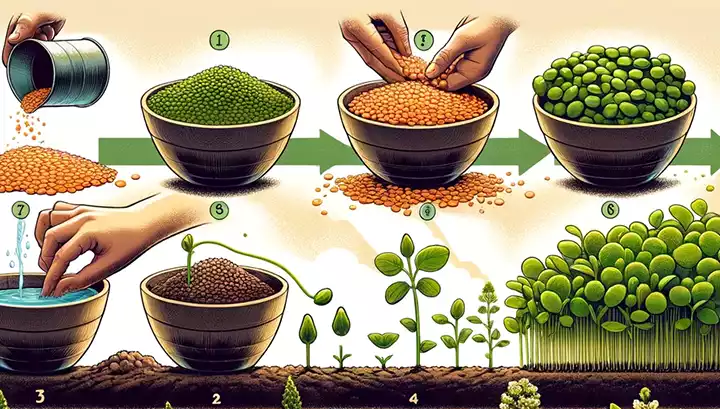In the realm of gardening and sustainable living, one often overlooked resource found right in our kitchens is lentils. These tiny seeds, commonly used in culinary dishes worldwide, possess remarkable potential to transform into lush, green plants that not only enrich the soil but also provide us with fresh, organic greens. Today, let’s delve into the world of lentil cultivation in our gardens, exploring the simplicity and benefits of growing this versatile legume.

The Hidden Gem in Your Kitchen: Lentils
Lentils, a staple in kitchens globally, are not just for soups and stews. These nutrient-packed seeds can be easily transformed into vibrant plants, offering an array of benefits for both your garden and your plate.
Why Grow Lentils?
- Soil Enrichment: Lentils are legumes, meaning they have the ability to fix nitrogen in the soil, enhancing its fertility for future crops.
- Easy to Grow: With minimal requirements for growth, lentils are an excellent choice for beginners and those with limited gardening space.
- Nutritional Value: The greens are not only edible but are also rich in nutrients, adding variety to your diet.
Step-by-Step Guide to Growing Lentils in Your Garden
Materials Needed:
- Lentil seeds (any variety from your kitchen)
- Potting soil or a prepared garden bed
- Compost or organic fertilizer (optional)
- Watering can
- A sunny spot in your garden or balcony

Steps:
1. Preparation:
- Select a sunny location for your lentil plants as they thrive in direct sunlight.
- Prepare the soil by loosening it and mixing in some compost or organic fertilizer to enrich it. Lentils prefer well-draining soil.
2. Planting:
- Soak the lentil seeds overnight in water to speed up germination.
- Sow the seeds directly into the soil, about 1 inch deep. Space them approximately 5 cm apart to allow for adequate air circulation and growth.
- If planting in rows, maintain a distance of about 20-30 cm between each row.
3. Watering:
- Water the newly planted seeds gently but thoroughly to moisten the soil.
- Keep the soil consistently moist but not waterlogged. Lentils do well with moderate watering.
4. Care:
- Lentils require minimal care. Monitor the soil moisture and water as needed.
- The plants enjoy full sunlight but can benefit from partial shade in extremely hot climates.
5. Harvesting:
- In about 4 months, your lentil plants will mature, flowering and producing pods.
- You can harvest the greens earlier if you prefer to eat them fresh. The young leaves are tender and can be added to salads or cooked like spinach.
6. Harvesting Lentil Seeds:
- Wait for the pods to mature and dry on the plant. Once dried, you can harvest the pods and extract the lentil seeds.
- Store the seeds in a cool, dry place for cooking or future planting.

Growing lentils in your garden is a rewarding endeavor that brings the cycle of food production full circle—from the kitchen to the garden and back to the kitchen.
This process not only provides you with fresh, organic produce but also contributes to a sustainable living practice by enriching the soil and promoting biodiversity.
Whether you’re an experienced gardener or just starting, consider planting lentils and discover the joy of watching these remarkable plants grow from a simple seed to a nourishing green.
